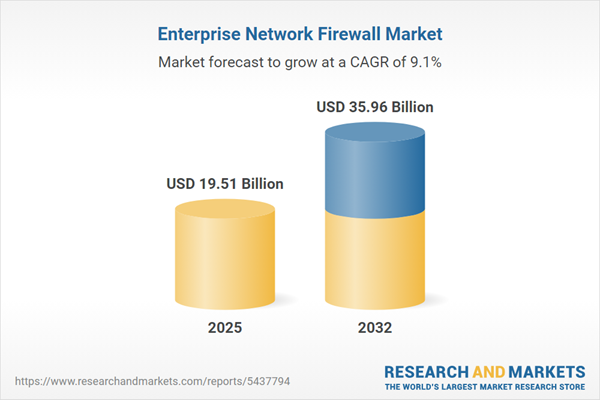Speak directly to the analyst to clarify any post sales queries you may have.
Amid dynamic cybersecurity challenges and evolving network architectures, the enterprise network firewall market demands strategic adaptation from organizations seeking optimal protection. This report enables senior decision-makers to quickly assess market developments, competitive dynamics, and key regional and segment trends to support future-ready investments.
Market Snapshot: Enterprise Network Firewall Market Size and Growth
The enterprise network firewall market grew from USD 17.87 billion in 2024 to USD 19.51 billion in 2025. Projected to expand at a CAGR of 9.13%, it will reach USD 35.96 billion by 2032. Driving factors include rising cyber threats, growth of cloud-native workloads, and increased regulatory focus in key geographies. The need for advanced policy enforcement, adaptive security, and seamless integration into distributed network environments accelerates demand for robust firewall solutions among global enterprises.
Scope & Segmentation of the Enterprise Network Firewall Market
This comprehensive research analyzes global and regional trends, focusing on industry-specific demands, procurement shifts, and technological advancements. Segmentation expands across solutions, deployment models, enterprise sizes, verticals, and regions:
- Components: Hardware, Services, Software
- Service Categories: Managed (Policy Management, Remote Monitoring), Professional (Integration & Consulting, Training & Support)
- Deployment Types: Cloud-Based (Hybrid Cloud, Private Cloud, Public Cloud), On-Premises
- Enterprise Sizes: Large Enterprises, Small & Medium Enterprises
- Industry Verticals: BFSI, Government & Defense, Healthcare, IT & Telecom, Manufacturing, Retail
- Geographies: Americas (North America, Latin America), Europe, Middle East & Africa (EMEA), Asia-Pacific
- Key Countries: United States, Canada, Mexico, Brazil, Argentina, Chile, Colombia, Peru, United Kingdom, Germany, France, Russia, Italy, Spain, Netherlands, Sweden, Poland, Switzerland, United Arab Emirates, Saudi Arabia, Qatar, Turkey, Israel, South Africa, Nigeria, Egypt, Kenya, China, India, Japan, Australia, South Korea, Indonesia, Thailand, Malaysia, Singapore, Taiwan
- Notable Companies: Fortinet, Cisco Systems, Palo Alto Networks, Check Point, Juniper Networks, Huawei, Sophos, Barracuda Networks, WatchGuard Technologies, SonicWall
Key Takeaways for Senior Decision-Makers
- Modern enterprise network firewall strategies align with zero trust principles, securing distributed and hybrid environments by verifying every access attempt.
- Cloud-native architectures and AI-driven automation are reshaping defense, enabling organizations to handle encrypted traffic, real-time segmentation, and increasingly complex workloads.
- Software-defined and managed firewall solutions are mitigating hardware procurement risks, particularly in response to tariff-driven supply chain disruptions.
- Regulation and compliance pressures in sectors like BFSI and healthcare demand advanced auditability and data localization from firewall deployments.
- Regional diversity influences adoption strategies. Mature markets prioritize unified security platforms, while emerging markets focus on scalable and localized solutions.
- Strategic vendor partnerships and targeted innovation—especially in deep packet inspection, microsegmentation, and automation—continue to differentiate leading technology providers.
Tariff Impact on Procurement and Security Investments
United States tariffs enacted in 2025 have contributed to greater volatility in firewall hardware supply chains. Enterprises increasingly favor software-centric and virtualized options, leveraging managed services and multi-sourcing relationships to stabilize procurement cycles and firefighting operational costs. This trend emphasizes the importance of buffer inventories and resilient supply planning in maintaining business continuity and compliance.
Methodology & Data Sources
The analysis combines primary interviews with experienced security architects, engineers, and procurement leads across industries and regions. Secondary sources supplement findings, including technical whitepapers, vendor literature, and global regulatory frameworks. Each insight is cross-validated for accuracy and relevance.
Why This Report Matters
- Provides actionable recommendations for optimizing firewall investments and adopting emerging technologies confidently.
- Clarifies competitive landscapes and regional differences, supporting procurement, risk management, and compliance strategies.
- Equips decision-makers with the knowledge to align firewall deployments with organizational resilience and growth objectives.
Conclusion
The enterprise network firewall market is evolving rapidly as organizations address sophisticated threats and new operational models. Strategic alignment, adaptability, and innovation are key to ensuring sustainable, future-ready network defense.
Additional Product Information:
- Purchase of this report includes 1 year online access with quarterly updates.
- This report can be updated on request. Please contact our Customer Experience team using the Ask a Question widget on our website.
Table of Contents
3. Executive Summary
4. Market Overview
7. Cumulative Impact of Artificial Intelligence 2025
Companies Mentioned
The companies profiled in this Enterprise Network Firewall market report include:- Fortinet, Inc.
- Cisco Systems, Inc.
- Palo Alto Networks, Inc.
- Check Point Software Technologies Ltd.
- Juniper Networks, Inc.
- Huawei Technologies Co., Ltd.
- Sophos Group plc
- Barracuda Networks, Inc.
- WatchGuard Technologies, Inc.
- SonicWall Inc.
Table Information
| Report Attribute | Details |
|---|---|
| No. of Pages | 186 |
| Published | October 2025 |
| Forecast Period | 2025 - 2032 |
| Estimated Market Value ( USD | $ 19.51 Billion |
| Forecasted Market Value ( USD | $ 35.96 Billion |
| Compound Annual Growth Rate | 9.1% |
| Regions Covered | Global |
| No. of Companies Mentioned | 11 |









